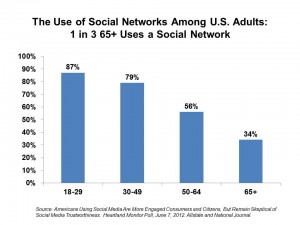 While 2 in 3 U.S. adults are active on social media, we are skeptical about trustworthiness of the content we find there. Welcome to the 13th quarterly Heartland Monitor Poll from Allstate and National Journal, surveying how U.S. adults look at social media, trust, and the political future of the nation.
While 2 in 3 U.S. adults are active on social media, we are skeptical about trustworthiness of the content we find there. Welcome to the 13th quarterly Heartland Monitor Poll from Allstate and National Journal, surveying how U.S. adults look at social media, trust, and the political future of the nation.
The Poll surveyed, by landline and cell phone, 1,000 U.S. adults over 18 in May 2012.
The most common social network used is Facebook, among 51% of U.S. adults, followed by Google+ (28%), Twitter (13%), LinkedIn (12%), Pinterest (6%), and MySpace (5%).
While Americans are drawn to using social media, people also see social media sites essentially as forms of advertising. This Jekyll-Hyde perspective on social networks is that while social media make it easier to be informed, we know that business and political interests use these channels to sell goods, services, and ideas. So we tend to rate public and traditional news media more highly on trust than we do information derived via social media outlets. Public TV and radio, continually under funding threat, are the most trusted media among 75% of American adults, followed by newspapers (71%), cable news (70%), network news (64%), magazines (57%), talk radio (53%), company websites (51%), ads (37%), blogs (34%) and social media sites — the least trusted channel — with 30% of public trust.
People on social networks tend to be more politically- and community-engaged, and are under greater influence from fellow friends on networks for buying decisions based on information gleaned in the networks in which they participate.
Ron Brownstein, editor of the National Journal, said in a press release, “In an economy that now offers individuals both more choices and more risks, most Americans have become reluctant individualists, trusting their own efforts, rather than any institution to provide them security.”
Health Populi’s Hot Points: With the loss of jobs and growing joblessness comes increasingly health care uninsurance and under-insurance status, along with eroding 401(k)s and, simultaneously, growing health care costs and burdens of cost-sharing. So the persona of “reluctant individualism” shadows most Americans, who may be taking on higher deductibles and the new responsibilities that fall on the growing number of people signing on to consumer-directed health plans.
Reluctant individualism leads to greater healthcareDIY — do-it-yourself health care — sometimes for better, sometimes for worse. The latest (May) Kaiser Health Tracking Poll found that the percent of people doing something to self-ration health care due to cost grew from 45% of U.S. adults in June 2012 to 58% in May 2012. These health cost-impacts included:
- skipping a recommended medical test or treatment, 25%
- not filling a prescription for a medicine, 24%
- cutting pills in half (without being instructed to do so by a physician or pharmacist), 16%
- having problems getting mental health care (8%)
- putting off or postponing getting needed health care (29%)
- skipping dental care (35%)
- relying on home remedies or OTC drugs instead of seeing a doctor (38%).
There is both art and science involved in people project- managing health as reluctant individualists: effective tools, relevant and easy-to-understand information, accessible goods and services that are consumer-engaging and well-designed are the underpinnings for that kind of health market to effectively worked. We’re not there yet, but watch for the likes of Consumer Reports, Castlight Health, Cakehealth, and other consumer-facing portals and tools to be funded and commercialized that will serve this growing demand.




 I am so grateful to Tom Lawry for asking me to pen the foreword for his book, Health Care Nation,
I am so grateful to Tom Lawry for asking me to pen the foreword for his book, Health Care Nation,  I love sharing perspectives on what's shaping the future of health care, and appreciate the opportunity to be collaborating once again with Duke Corporate Education and a global client on 6th May. We'll be addressing some key pillars to consider in scenario planning such as growing consumerism in health care, technology (from AI to telehealth), climate change, and trust -- the key enabler for health engagement or dis-engagement and mis-information. I'm grateful to be affiliated with the corporate education provider
I love sharing perspectives on what's shaping the future of health care, and appreciate the opportunity to be collaborating once again with Duke Corporate Education and a global client on 6th May. We'll be addressing some key pillars to consider in scenario planning such as growing consumerism in health care, technology (from AI to telehealth), climate change, and trust -- the key enabler for health engagement or dis-engagement and mis-information. I'm grateful to be affiliated with the corporate education provider  Thank you FeedSpot for
Thank you FeedSpot for